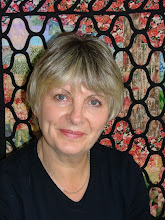Blog 420
And so the creating begins. My method, which I am
re-visiting after many years, relies on haphazardness and irregularity so it
suits me fine! To start I drew a rough shape to represent a flower pot and
marked where the lightest area was going to be. And then I started to ‘colour’
in this shape with ready bonded rectangles, all cut with a pinked rotary blade.
I started with darker shades and worked towards the light area.
Separately, I worked leaf shapes on some of the release
paper from the Bondaweb (baking parchment works well also) and positioned these
at the top of the container.
I decided to increase the range of fabrics at my disposal.
This involved adding fusible to the WS of the chosen fabrics and I do this by over-lapping
them on a long strip of Bondaweb and ironing them well. The fusible needed to
be stuck thoroughly and a good test of that is to look at the release paper to
see if has changed to a darker grey. Any light parts indicate that the fusible
hasn’t stuck and more ironing is needed.

The (release paper) backing paper can be carefully removed
in one sheet and it is very useful for building up shapes/designs on or as a
layer on top of the project to protect the iron. When the fused fabrics are
tugged apart, the over-lapped (and therefore unfused areas) are clearly visible
and these can be removed easily. The fabrics need to be cut with a pinked rotary
cutter blade into random lines and then rectangles.
















No comments:
Post a Comment